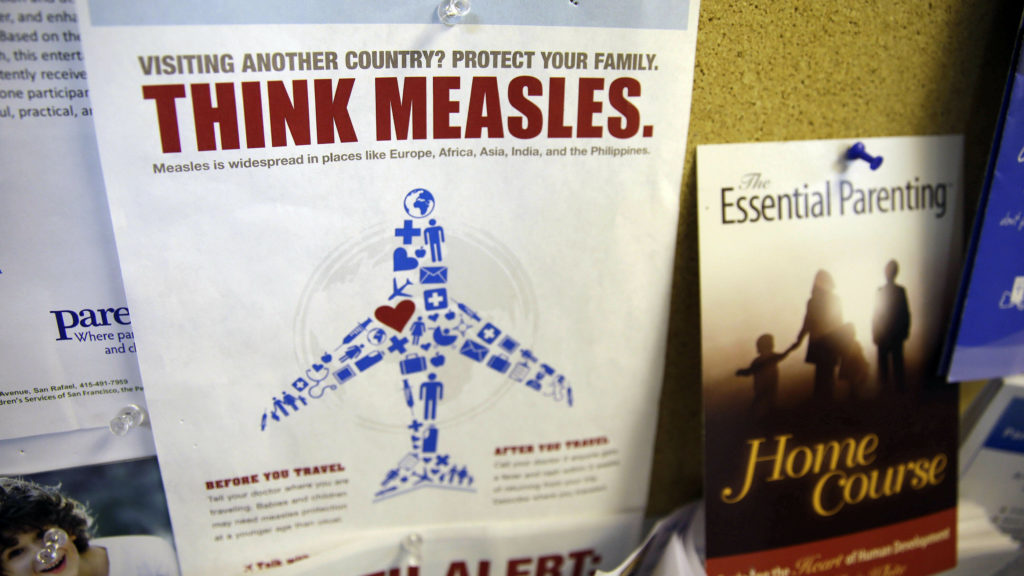The Ongoing Threat Of Measles: Factors Contributing To Persistence

Table of Contents
Vaccine Hesitancy and Misinformation
The rise of vaccine hesitancy and the spread of misinformation are major contributors to measles persistence. Anti-vaccine sentiments, fueled by inaccurate claims and conspiracy theories, have significantly reduced vaccination rates in many communities, creating fertile ground for outbreaks. These sentiments often stem from a distrust of scientific evidence and established healthcare systems.
-
Spread of misinformation through social media: The rapid dissemination of false information via social media platforms has amplified anti-vaccine narratives, reaching a vast audience and undermining public health efforts. Misleading posts and videos often go viral, making it challenging to counter their influence effectively.
-
Influence of celebrity endorsements of anti-vaccine views: High-profile individuals endorsing anti-vaccine beliefs can significantly impact public opinion, especially among those already susceptible to misinformation. These endorsements lend an air of legitimacy to unfounded claims, further eroding confidence in vaccines.
-
Lack of trust in healthcare systems and authorities: Mistrust in governmental institutions and healthcare providers plays a crucial role in vaccine hesitancy. Negative experiences, perceived biases, or lack of transparent communication can contribute to this distrust, making individuals less receptive to vaccination messages.
-
Misunderstandings about vaccine safety and efficacy: Many individuals harbor misconceptions about vaccine safety, believing they cause autism or other adverse effects, despite overwhelming scientific evidence to the contrary. These misunderstandings, often stemming from misinterpretations or deliberate misinformation, contribute to vaccine avoidance.
Gaps in Vaccination Coverage
Unequal access to vaccines, particularly in underserved communities, remains a significant barrier to measles eradication. Poverty, lack of healthcare infrastructure, and geographical barriers contribute to low vaccination rates in these vulnerable populations, making them disproportionately susceptible to outbreaks.
-
Challenges in reaching remote or marginalized populations: Reaching remote communities, those experiencing displacement, or marginalized groups can prove incredibly difficult, limiting the effective delivery of vaccines. Lack of access to healthcare facilities, transportation issues, and cultural barriers contribute to this challenge.
-
Cost of vaccines as a barrier to access: The financial burden of vaccines, even in countries with vaccination programs, can prevent low-income families from accessing them. This disparity exacerbates existing health inequalities and fuels measles persistence.
-
Lack of awareness about the importance of vaccination: In some regions, awareness of the importance of measles vaccination remains low, leading to complacency and vaccine refusal. This lack of knowledge underscores the need for targeted public health education campaigns.
-
Inadequate healthcare worker training on vaccine administration and education: Proper training and education of healthcare workers are critical for effective vaccine delivery and education. Insufficient training can lead to inadequate vaccine administration, missed opportunities for vaccination, and a lack of effective communication with patients about the benefits of vaccination.
The Role of International Travel and Migration
International travel and migration significantly influence the spread of measles. The movement of infected individuals across borders can quickly introduce measles into new areas, even those with high vaccination rates. This necessitates robust global vaccination strategies and international collaboration.
-
Increased risk of imported measles cases: Travelers returning from regions with ongoing measles outbreaks can inadvertently introduce the virus into countries with low incidence rates, triggering local outbreaks.
-
Challenges in tracking and containing outbreaks across borders: Monitoring and controlling measles outbreaks across international borders requires a coordinated global response. Tracking the movement of infected individuals and implementing effective quarantine measures are critical components.
-
Need for international collaboration on vaccination initiatives: Effective measles control requires international cooperation and coordinated vaccination initiatives. Sharing best practices, resources, and data across borders is essential for a global approach.
-
Importance of pre-travel vaccination recommendations: Pre-travel vaccinations are essential for reducing the risk of importing measles into countries with high vaccination rates. Providing accurate and accessible information on recommended vaccinations before international travel is crucial.
Weakening of Herd Immunity
Low vaccination rates significantly weaken herd immunity, the indirect protection of unvaccinated individuals afforded by high vaccination rates within a population. Falling below the threshold for herd immunity (estimated to be around 95%) increases the susceptibility of entire communities to measles outbreaks, even among those previously vaccinated.
-
The concept of herd immunity and its importance: Herd immunity is a crucial concept in preventing the spread of infectious diseases. High vaccination rates protect not only vaccinated individuals but also those who cannot be vaccinated due to medical reasons.
-
The impact of declining vaccination rates on herd immunity: Declining vaccination rates directly undermine herd immunity, making communities more vulnerable to measles outbreaks. Even small reductions in vaccination coverage can have a significant impact.
-
Consequences of insufficient herd immunity: increased disease transmission: Insufficient herd immunity leads to increased disease transmission, resulting in larger and more widespread outbreaks. This can strain healthcare systems and lead to preventable hospitalizations and even deaths.
Conclusion
Measles persistence is a complex problem resulting from a combination of factors: vaccine hesitancy fueled by misinformation, gaps in vaccination coverage, particularly in underserved populations, the facilitation of spread through international travel, and the weakening of herd immunity due to low vaccination rates. Addressing these challenges requires a multi-pronged approach. Improved public health initiatives, increased access to vaccines, particularly in remote and marginalized areas, and effective communication campaigns to counter misinformation are urgently needed. Understanding the factors contributing to measles persistence is crucial for effective disease control. Let's work together to ensure high vaccination rates and protect our communities from this preventable disease. Learn more about measles vaccination and advocate for increased access to vaccines in your community.

Featured Posts
-
 Nissans Classic Nameplate Comeback Is It The Z
May 30, 2025
Nissans Classic Nameplate Comeback Is It The Z
May 30, 2025 -
 Monte Carlo Masters Alcarazs Stunning Rally And First Win
May 30, 2025
Monte Carlo Masters Alcarazs Stunning Rally And First Win
May 30, 2025 -
 Canadas Measles Elimination Status At Risk A Fall Threat
May 30, 2025
Canadas Measles Elimination Status At Risk A Fall Threat
May 30, 2025 -
 Motor Sport 197 Hp Kawasaki Z H2 Kenapa Indonesia Tidak Mendapatkannya
May 30, 2025
Motor Sport 197 Hp Kawasaki Z H2 Kenapa Indonesia Tidak Mendapatkannya
May 30, 2025 -
 Analyzing The Impact Of Trumps Trade War On Canada 8 Economic Indicators
May 30, 2025
Analyzing The Impact Of Trumps Trade War On Canada 8 Economic Indicators
May 30, 2025
